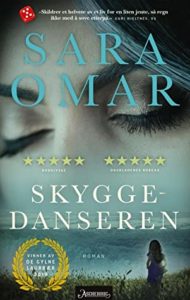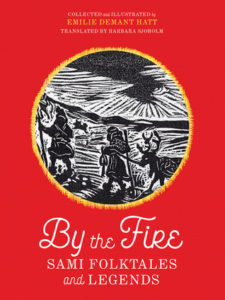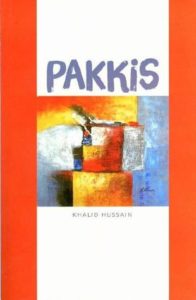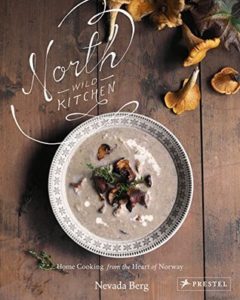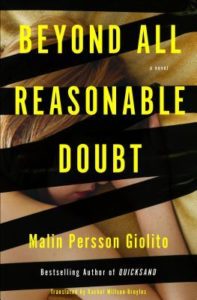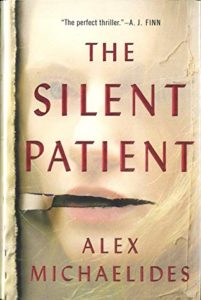
There’s no time like the present to consider reading a book or two by a woman in translation. August is Women in Translation Month (#WITMonth), an annual initiative to raise awareness of and promote women writers from around the world who write in languages other than English. With international travel limited due to the pandemic and the Olympics going on in Tokyo, why not do some armchair traveling to countries of interest through books by women in translation?
Every year I set aside August to read women in translation from outside Scandinavia (since I read plenty of them regularly). I create a stack of books I’m interested in reading and see what piques my interest most when the time comes for a new book. On my TBR pile for August are books that will transport me to Spain (Basque Country), France, Italy, Iran, Rwanda, and Thailand through the voices of female authors from the region. I usually get a head start in July and continue into the fall.
Are you interested in joining this year? Here are my 10 current favorite books by women in translation. As you might expect, the list is heavy on Scandinavian female authors, but there are some other gems tucked in there as well. Please share in the comments any books in translation by women that you’ve enjoyed. I’m especially looking for female authors from South America.
Kristin Lavransdatter 1: The Wreath by Sigrid Undset 🇳🇴
(Tr. from the Norwegian by Tiina Nunnally, published by Penguin Classics)
This is the first in an historical fiction trilogy set in medieval Norway.
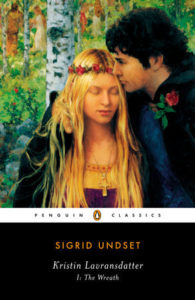 I was surprised by how much I enjoyed this book! It was nothing like what I expected. Kristin is quite the rebel and the book seems quite risqué for its time (first published in 1920). Broken betrothals, premarital rendezvous, poison, suicide, and coverups – so unexpected. It was interesting to learn about life in medieval Norway, and the descriptions of the setting are especially beautiful. This first book is the story of how Kristin met and was wooed by the handsome Erlend, breaking up her betrothal to another man. The series continues with her marriage to Erlend and follows her as she raises seven sons. I enjoyed this book so much that I completed the trilogy in the next couple of years, but this was my favorite of the three. Make sure to read the translation by Tiina Nunnally.
I was surprised by how much I enjoyed this book! It was nothing like what I expected. Kristin is quite the rebel and the book seems quite risqué for its time (first published in 1920). Broken betrothals, premarital rendezvous, poison, suicide, and coverups – so unexpected. It was interesting to learn about life in medieval Norway, and the descriptions of the setting are especially beautiful. This first book is the story of how Kristin met and was wooed by the handsome Erlend, breaking up her betrothal to another man. The series continues with her marriage to Erlend and follows her as she raises seven sons. I enjoyed this book so much that I completed the trilogy in the next couple of years, but this was my favorite of the three. Make sure to read the translation by Tiina Nunnally.
Convenience Store Woman by Sayaka Murata 🇯🇵
(Tr. from the Japanese by Ginny Tapley Takemori, published by Grove Press)
This is contemporary fiction set in Tokyo, Japan.
 This book was a little gem — small, short, and heartwarming. I took a great liking to Keiko, a somewhat peculiar 36-year-old woman who’s been working part time at a convenience store in Tokyo for 18 years. Her whole being, both at the store and at home, is so attuned to the rhythms and needs of the store. Keiko thrives following the directives of the store manual and absorbing others’ dress, mannerisms, and speech. Despite her quirkiness, she has friends and is accepted and valued at her job. Also, I loved getting a glimpse into the Japanese culture through this convenience store and its workers.
This book was a little gem — small, short, and heartwarming. I took a great liking to Keiko, a somewhat peculiar 36-year-old woman who’s been working part time at a convenience store in Tokyo for 18 years. Her whole being, both at the store and at home, is so attuned to the rhythms and needs of the store. Keiko thrives following the directives of the store manual and absorbing others’ dress, mannerisms, and speech. Despite her quirkiness, she has friends and is accepted and valued at her job. Also, I loved getting a glimpse into the Japanese culture through this convenience store and its workers.
Waiting for Tomorrow by Nathacha Appanah 🇫🇷
(Tr. from the French by Geoffrey Strachan, published by Graywolf Press)
This is contemporary fiction set in France by a Mauritian-French author.
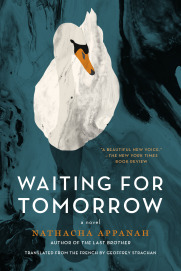 Anita and Adam meet as students in Paris. She’s an immigrant from Mauritius and he’s from the French provinces. They both feel out of place but find comfort and love with each other. They move to the provinces, get married, and have a daughter. Life happens. She freelances for a local paper instead of writing the next great novel. He works at an architecture firm instead of devoting his life to painting. And then Adèle enters their life, resetting it in an unexpected way. It’s a short novel that packs a lot into its pages. It explores immigration, including undocumented immigrants; cultural differences in society and within a marriage; family and motherhood (stay-at-home vs working mothers), and ambitions. It’s a tragic story but beautifully written.
Anita and Adam meet as students in Paris. She’s an immigrant from Mauritius and he’s from the French provinces. They both feel out of place but find comfort and love with each other. They move to the provinces, get married, and have a daughter. Life happens. She freelances for a local paper instead of writing the next great novel. He works at an architecture firm instead of devoting his life to painting. And then Adèle enters their life, resetting it in an unexpected way. It’s a short novel that packs a lot into its pages. It explores immigration, including undocumented immigrants; cultural differences in society and within a marriage; family and motherhood (stay-at-home vs working mothers), and ambitions. It’s a tragic story but beautifully written.
Love by Hanne Ørstavik 🇳🇴
(Tr. from the Norwegian by Martin Aitken, published by Archipelago)
This is contemporary fiction set in northern Norway.
 This is the story of an 8-year-old boy and his mother who have recently moved to a remote village in northern Norway. They live together but lead totally separate lives. The story takes place one very cold winter night in the space of only a few hours. The boy is eagerly anticipating his birthday the next day, but his mother is wrapped up in her own world and desires. It alternates between the boy’s and the mother’s separate outings during the evening. What I thought might happen didn’t, and what I didn’t anticipate happened. It was a sad but beautiful story. At times it actually felt somewhat surreal.
This is the story of an 8-year-old boy and his mother who have recently moved to a remote village in northern Norway. They live together but lead totally separate lives. The story takes place one very cold winter night in the space of only a few hours. The boy is eagerly anticipating his birthday the next day, but his mother is wrapped up in her own world and desires. It alternates between the boy’s and the mother’s separate outings during the evening. What I thought might happen didn’t, and what I didn’t anticipate happened. It was a sad but beautiful story. At times it actually felt somewhat surreal.
The History of Bees: A Novel by Maja Lunde 🇳🇴
(Tr. from the Norwegian by Diane Oatley, published by Atria Books)
This is historical fiction set in England, contemporary fiction set in the USA, and dystopian fiction set in China all rolled into in one novel.
 This is such an interestingly structured and thought-provoking book about humans’ relationship to bees as well as relationships and expectations between family members. It’s a look at the role of bees in the past, present, and future from the perspective of a family in each of those time periods, and over time their stories intersect. The first storyline takes place in England in the mid-1850s when beehives are being improved, the second one in the USA in 2007 when there is an increase in the number of colony collapse disorders happening, and the last one in China in 2098 when humans must hand-pollinate due to the total collapse of bees. As the book progresses, the reader begins to see how the three families’ stories intersect.
This is such an interestingly structured and thought-provoking book about humans’ relationship to bees as well as relationships and expectations between family members. It’s a look at the role of bees in the past, present, and future from the perspective of a family in each of those time periods, and over time their stories intersect. The first storyline takes place in England in the mid-1850s when beehives are being improved, the second one in the USA in 2007 when there is an increase in the number of colony collapse disorders happening, and the last one in China in 2098 when humans must hand-pollinate due to the total collapse of bees. As the book progresses, the reader begins to see how the three families’ stories intersect.
This is the first in Maja Lunde’s Climate Quartet. Next is The End of the Ocean which I also enjoyed, followed by The Last Wild Horses: A Novel (to be released in English February 15, 2022). The fourth book is still a work in progress.
Human Acts by Han Kang 🇰🇷
(Tr. from the Korean by Deborah Smith, published by Hogarth)
This is historical fiction set in South Korea.
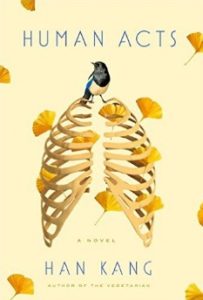 This novel was about a horrific historical event I had never heard of before, the violent 1980 student uprising in Gwangju, South Korea. The story is told through chapters that are interconnected short stories. In the first chapter, which takes place in 1980, readers are introduced to several characters who then reappear in the next chapters over a period of 30 years. Interestingly, the chapters are either in first or second person with one chapter in third person. Be aware, Han Kang does not shy away from the gruesome details of this violent time, but at the same time, she shares examples of kindness and compassion too. (I have also read and enjoyed The Vegetarian, but I liked Human Acts better.)
This novel was about a horrific historical event I had never heard of before, the violent 1980 student uprising in Gwangju, South Korea. The story is told through chapters that are interconnected short stories. In the first chapter, which takes place in 1980, readers are introduced to several characters who then reappear in the next chapters over a period of 30 years. Interestingly, the chapters are either in first or second person with one chapter in third person. Be aware, Han Kang does not shy away from the gruesome details of this violent time, but at the same time, she shares examples of kindness and compassion too. (I have also read and enjoyed The Vegetarian, but I liked Human Acts better.)
The Nakano Thrift Shop by Hiromi Kawakami 🇯🇵
(Tr. from the Japanese by Allison Markin Powell, published by Europa Editions)
This is contemporary fiction set in Tokyo, Japan.
 I thought this was going to contain some magical realism (since the cover I had originally seen has a woman flying into a subway train), but no, it was a down-to-earth look at the happenings and people in a neighborhood thrift shop in the suburbs of Tokyo. The main character, Hitomi, works the cash register. Her boss and the owner of the thrift shop is Mr. Nakano, a somewhat odd and mysterious person. His sister Masayo, an unmarried artist, is a regular presence in the store. And then there’s Takeo, the shy part-time co-worker who helps with pick-ups and on whom Hitomi has a crush. It’s an eclectic group of people, and I love a story with unlikely friendships. I also enjoyed getting a glimpse of everyday life in Japan.
I thought this was going to contain some magical realism (since the cover I had originally seen has a woman flying into a subway train), but no, it was a down-to-earth look at the happenings and people in a neighborhood thrift shop in the suburbs of Tokyo. The main character, Hitomi, works the cash register. Her boss and the owner of the thrift shop is Mr. Nakano, a somewhat odd and mysterious person. His sister Masayo, an unmarried artist, is a regular presence in the store. And then there’s Takeo, the shy part-time co-worker who helps with pick-ups and on whom Hitomi has a crush. It’s an eclectic group of people, and I love a story with unlikely friendships. I also enjoyed getting a glimpse of everyday life in Japan.
Knots: Stories by Gunnhild Øyehaug 🇳🇴
(Tr. from the Norwegian by Kari Dickson, published by Farrar, Straus and Giroux)
This a collection of short stories set in Norway.
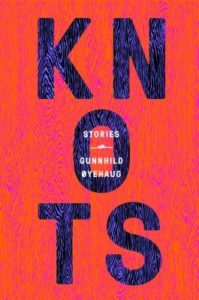 This collection of short stories is the author’s English language debut — 13 years after its initial Norwegian publication. The book is an eclectic collection of stories all of which explore the mind and thoughts of people in a variety of situations. Many are surreal; others are realistic. There is little action. They mostly deal with the characters’ consciousness. I was oddly transfixed by the stories. The book is small and slim, and the stories are short so I just kept turning the pages to see what creative and unique story would come next.
This collection of short stories is the author’s English language debut — 13 years after its initial Norwegian publication. The book is an eclectic collection of stories all of which explore the mind and thoughts of people in a variety of situations. Many are surreal; others are realistic. There is little action. They mostly deal with the characters’ consciousness. I was oddly transfixed by the stories. The book is small and slim, and the stories are short so I just kept turning the pages to see what creative and unique story would come next.
Quicksand by Malin Persson Giolito 🇸🇪
(Tr. from the Swedish by Rachel Willson-Broyles, published by Other Press)
This is contemporary fiction/crime fiction set in a suburb of Stockholm, Sweden.
 The author takes us into the mind of 18-year-old Maja who’s on trial for her involvement in a school shooting in a wealthy suburb of Stockholm, Sweden, that left her boyfriend and best friend dead, along with others. We alternate between her time in the jail cell and in the courtroom along with flashbacks to her life leading up to the shooting. The book started a little slow, but as I got further into it, it was a page-turner that had me very eager to find out how it all could have come to this. Many timely issues to consider: school shootings, mental health, immigration, gun violence, wealth, class, parenting.
The author takes us into the mind of 18-year-old Maja who’s on trial for her involvement in a school shooting in a wealthy suburb of Stockholm, Sweden, that left her boyfriend and best friend dead, along with others. We alternate between her time in the jail cell and in the courtroom along with flashbacks to her life leading up to the shooting. The book started a little slow, but as I got further into it, it was a page-turner that had me very eager to find out how it all could have come to this. Many timely issues to consider: school shootings, mental health, immigration, gun violence, wealth, class, parenting.
The Murmur of Bees by Sofía Segovia 🇲🇽
(Tr. from the Spanish by Simon Bruni, published by Amazon Crossing)
This is historical fiction with a touch of magical realism set in Mexico.
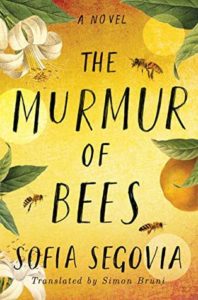 This is about an established landowning family in a small northern Mexican town in the early 1900s during the Mexican Revolution. An abandoned child covered in bees is discovered and then adopted by the family. This child, who is deformed and cannot speak and always accompanied by a swarm of bees, turns out to be a blessing for the family as they endure life in their little town with its human and natural challenges. It was a little slow to get going, but suddenly I was very absorbed in the story.
This is about an established landowning family in a small northern Mexican town in the early 1900s during the Mexican Revolution. An abandoned child covered in bees is discovered and then adopted by the family. This child, who is deformed and cannot speak and always accompanied by a swarm of bees, turns out to be a blessing for the family as they endure life in their little town with its human and natural challenges. It was a little slow to get going, but suddenly I was very absorbed in the story.
Special Mentions
Celestial Bodies by Jokha Alharthi
(Tr. from the Arabic by Marilyn Booth, published by Catapult)
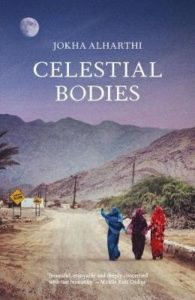 This is a uniquely structured novel that follows three sisters who live in a village outside the capital city of Muscat in Oman. One sister marries after realizing she’ll never have the one she truly desires. Another sister marries out of obligation. And the third sister refuses to marry and instead waits for her beloved to return from Canada. The chapters jump between the first person perspective of the first sister’s husband and the third person perspective of various family and community members. It was hard to keep track of characters (grateful for the family tree at the beginning!) and time, but I was fascinated by the lives of these women in contemporary Oman, so different from what I’m used to or been exposed to in reading before. And I learned a bit about the history of the region which was interesting as well. This author has the special distinction of being the first female Omani novelist to be translated into English. The book won the International Booker Prize in 2019.
This is a uniquely structured novel that follows three sisters who live in a village outside the capital city of Muscat in Oman. One sister marries after realizing she’ll never have the one she truly desires. Another sister marries out of obligation. And the third sister refuses to marry and instead waits for her beloved to return from Canada. The chapters jump between the first person perspective of the first sister’s husband and the third person perspective of various family and community members. It was hard to keep track of characters (grateful for the family tree at the beginning!) and time, but I was fascinated by the lives of these women in contemporary Oman, so different from what I’m used to or been exposed to in reading before. And I learned a bit about the history of the region which was interesting as well. This author has the special distinction of being the first female Omani novelist to be translated into English. The book won the International Booker Prize in 2019.
Tropic of Violence by Nathacha Appanah
(Tr. from the French by Geoffrey Strachen, published by Graywolf Press)
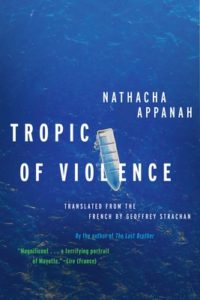 This book took me to a place in the world I’ve never been in my reading life, Department of Mayotte, a French island in the Indian Ocean between Mozambique and Madagascar. When Marie suddenly dies, her 14-year-old adopted son Moïse is left to fend for himself. He ends up involved with a gang in the largest slum on the island. The book explores hard issues – illegal immigration, poverty, race, class, youth gangs, and violence – through the perspectives of not only Marie and Moïse, but also the gang leader, a police officer, and an aid worker. This was a tough read, not a feel good book at all, but definitely an eye-opening and thought-provoking reading experience about a new-to-me part of the world, exactly why I like participating in #WITMonth.
This book took me to a place in the world I’ve never been in my reading life, Department of Mayotte, a French island in the Indian Ocean between Mozambique and Madagascar. When Marie suddenly dies, her 14-year-old adopted son Moïse is left to fend for himself. He ends up involved with a gang in the largest slum on the island. The book explores hard issues – illegal immigration, poverty, race, class, youth gangs, and violence – through the perspectives of not only Marie and Moïse, but also the gang leader, a police officer, and an aid worker. This was a tough read, not a feel good book at all, but definitely an eye-opening and thought-provoking reading experience about a new-to-me part of the world, exactly why I like participating in #WITMonth.
Dødevaskeren (The Dead Washer) by Sara Omar
(Tr. from the Danish to the Norwegian by Hilde Rød-Larsen, published by Aschehoug)
 This book is unfortunately not translated into English yet, but I include it on this list for anyone who can read Danish, Norwegian, Swedish, French, or any other language it might already be translated into. It’s an amazing and heartbreaking novel dealing with the oppression of Muslim women, in particular in the Kurdistan region of Iraq. The book is about a girl named Frmesk born in Kurdistan in 1986. She is unwanted by her father because she’s a girl. She is sent to live with her mother’s parents because the mother is afraid for the baby’s life if she stays at home. Her grandparents are very kind, loving, open-minded “parents” to Frmesk in a world where the Koran rules and women’s rights and freedoms are non-existent. The story moves between Frmesk’s life as a young child in her grandparents’ household and Frmesk’s life in Denmark 30 years later when she’s alone in a hospital bed for unidentified procedures. Real events, such as the 1988 Halabja chemical attack, are included in the story. It was an extremely engrossing and engaging story despite the difficult subject material. Sara Omar’s second book, Skyggedanseren (The Shadow Dancer), a follow-up to the first, also made a very strong impression on me.
This book is unfortunately not translated into English yet, but I include it on this list for anyone who can read Danish, Norwegian, Swedish, French, or any other language it might already be translated into. It’s an amazing and heartbreaking novel dealing with the oppression of Muslim women, in particular in the Kurdistan region of Iraq. The book is about a girl named Frmesk born in Kurdistan in 1986. She is unwanted by her father because she’s a girl. She is sent to live with her mother’s parents because the mother is afraid for the baby’s life if she stays at home. Her grandparents are very kind, loving, open-minded “parents” to Frmesk in a world where the Koran rules and women’s rights and freedoms are non-existent. The story moves between Frmesk’s life as a young child in her grandparents’ household and Frmesk’s life in Denmark 30 years later when she’s alone in a hospital bed for unidentified procedures. Real events, such as the 1988 Halabja chemical attack, are included in the story. It was an extremely engrossing and engaging story despite the difficult subject material. Sara Omar’s second book, Skyggedanseren (The Shadow Dancer), a follow-up to the first, also made a very strong impression on me.
Have I persuaded you to pick up a book by a woman in translation?
By the way, if you’re interested in snagging some Scandinavian ebooks at a great discount, many by Scandinavian female authors, check out my Scandinavian Ebook Deals. Some offers stay around for a long time, others only a short period. If anything looks intriguing, grab it before it’s gone.
Disclaimer: AVikingInLA is a participant in the Amazon Services LLC Associates Program, an affiliate advertising program designed to provide a means for sites to earn advertising fees by advertising and linking to amazon.com.


